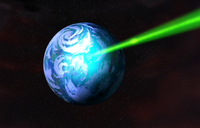| | |

A planetary shield, commonly known as a planetary deflector shield (or defense grid), was a large scale deflector shield designed to protect an entire planet from bombardment, falling debris, or other hazards. The term planetary shield may also have been used for a large scale shield protecting a moon such as Nar Shaddaa.
Description[]
Planetary shields were layers of invisible energy generated by planetary shield generators which had enough power to dissipate turbolaser blasts and to deflect and destroy space debris such as asteroids and comets. Starships coming into contact with a planetary shield were usually destroyed or severely damaged. Due to the shields being invisible to the naked eye, sensors were required to detect the presence of raised shields around a planet.[1]
The energy requirements to keep a planetary shield operational were enormous; as a result, planetary shields were often kept deactivated and only powered up when needed. Some models of planetary shield required as long as half an hour to activate and bring to full strength. In these cases, planets employed a network of turbolaser and ion cannon emplacements to hold enemy forces at bay until the shield was operational.[1]
Shield generators were strategically stationed on the planet's surface. Since the deflector shield generator required a continuous supply of energy output the maintenance costs for such a protection device were generally high. This is the main reason why planetary shields were usually constructed on planets that had important military installations, served as major commercial hubs, or had a significantly large number of inhabitants which could economically support such an expensive project.
The strength of a planetary deflector shield was a factor depending on how close the shield was to the projector, the efficiency of the projector, the power applied, and the surface area of the shield.
History[]

Alderaan's shield overwhelmed by the Death Star's superlaser.
The first deflector shields were developed to protect individual starships against various space hazards including attacks from other ships. The technology was later adapted for use aboard space stations, but the shields remained best suited to repelling starfighters.
Shield technology was first expanded from protecting starships to entire planets in 3631 BBY to protect Odessen. Doctor Juvard Illip Oggurobb developed the technology on behalf of the Alliance in time for Emperor Arcann's attack at the Battle of Odessen. The planetary shield prevented the Eternal Fleet from bombarding the Alliance base and forced the battle to be space-based confrontation.[2]
Planetary shields could be scaled to cover bases, cities, or even entire planets. One of the two main types of planetary shields, encasing shields (like the second Death Star's), prohibited friendly fire from beneath the shield except through small gaps. Encasing shields could be curved to protect orbiting objects and seriously damaged the systems of craft that passed through them. The second type of planetary shield, a shutter shield, was more versatile in that segments could be moved to overlap others for increased defense, but shutter shields did less damage to craft passing through them and could not be oriented in a curve. The Rebel base on Hoth employed shutter shields. Both types of planetary shields fouled sensor scans.[3]
Pacifistic planets like Alderaan[4] and Naboo,[5] often relied on passive defenses like planetary shields instead of using more aggressive measures to ensure the populace's safety. The former was stated to be as strong as the defensive systems of the Empire.[4]
Battlestations such as Torpedo Spheres or Death Stars were designed to penetrate planetary shields. When such weapons were unavailable, planetary shields were often sabotaged as a prelude to either conquest (as in the conquest of Mon Calamari), or an orbital bombardment (as in the destruction of Caamas or the Second Battle of Bothawui).

